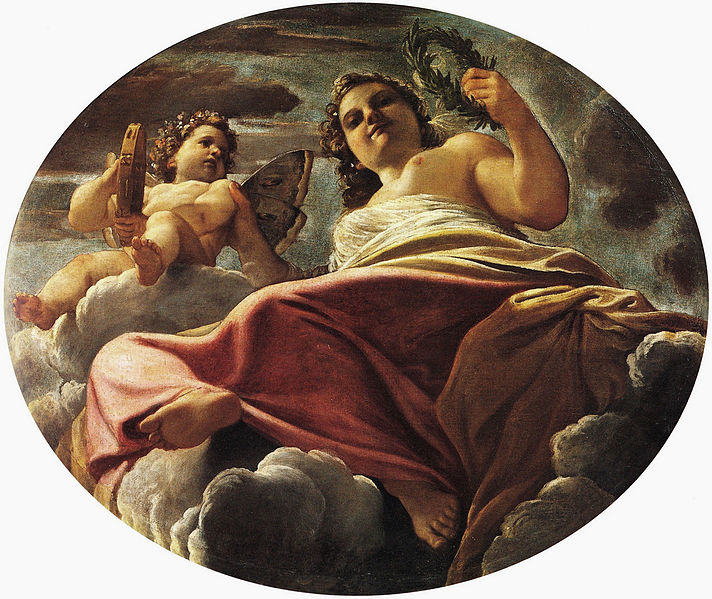The Carracci cousins worked on a series of four oval canvases with mythological themes commissioned by Cesare d’Este to decorate the ceiling of the Stanza del Poggiolo in the Palazzo dei Diamanti in Ferrara. The ceiling decoration is completed by eleven canvases, of which four are by the Carracci and depict Venus painted by Annibale, Pluto executed by Agostino, while Galatea and Flora presumably works by Ludovico remain of more controversial attribution both as subject and hand.
The figures show massive and carnal bodies, characteristics softened by an already mature naturalism. The deities are painted in strong perspective foreshortening, as the canvases were housed in the ceiling and thus had to be viewed from below.
Annibale paints a Venus gently leaning against a cloud, intent on looking at Love represented as a blond-haired putto armed with a bow and quiver who turns his gaze towards the viewer. Blonde-haired Venus has her head encircled by a crown of flowers and holds a golden apple in her right hand. Below the figures are painted two white doves.
Pluto is portrayed by Agostino as a dark, powerful and muscular man. At his side is Cerberus, the three-headed dog, made fearsome by his large, open jaws. The god is portrayed in a pensive attitude with his gaze turned downwards while he runs his right hand through his thick black beard, in his left hand he holds a key protected by the terrible animal.

Flora, among the four paintings executed by the Carracci, presents the composition with the most courageous perspective cut, in fact she is depicted upright instead of semi-recumbent. The goddess seated on a dense cloud turns her gaze towards the viewer, next to her sits a cupid with fanciful butterfly wings intent on playing a tambourine. Flora holds a laurel crown in her left hand and, unlike the other figures depicted without veils, wears a robe that leaves one of her breasts uncovered.

The other divinity painted by Ludovico has had, like the previous one, a controversial identification, recognised, perhaps, as Galatea, other hypotheses define her as the Nereid Opi, while in more recent times Sonia Cavicchioli has proposed an identification with Salacia, a marine divinity wife of Neptune. The goddess with long blond hair pulled back over her forehead, holds the reins of a shell-shaped chariot pulled by sea animals, floating in the waves of a stormy sea. The dark tone of the work is brightened by the red drape resting on the goddess’ legs.

Since Palazzo dei Diamanti was an allodial property, and therefore still in the possession of the Este family even after the Devolution of Ferrara, the paintings remained there until the beginning of the 17th century when they were transported to Modena. At the end of the 18th century the four paintings were confiscated by Napoleon and took the way to Paris, fortunately they were returned to Italy in 1815. The canvases are today exhibited in the Galleria Estense in Modena.







